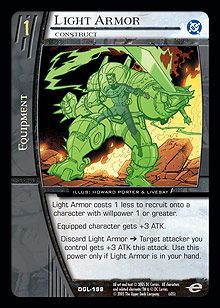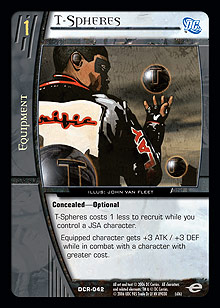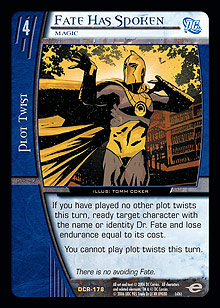As some of you already know, Infinite Crisis was the first set I worked on. When I started working on the development team, there were many things I took for granted as a player. As time went by, I learned a great deal. In this article, I will highlight some of the things I learned.
When I took this job, I thought designing and developing a set was mostly about paying very close attention to how the new 220 cards would interact with the thousands of cards already designed. Man, was I wrong! You have to take flavor, card art, Draft, Sealed Pack, various Constructed formats, and the fun factor all into consideration.
 As a player, I found that drafting equipment was never a viable strategy. In Green Lantern, R&D took some major steps toward fixing this by introducing equipment like Light Armor. Giving equipment a plot twist–like effect in addition to its primary function made the card type much more playable. The main reason why equipment wasn’t playable before was because every Sealed deck had only so much room for your curve and plot twists. To put equipment like Jetpack in your deck, you either had to pay a cost by removing a plot twist from your deck that could be used as a resource, or shave a drop out of your deck somewhere. This caused you to run the risk of missing one of your drops in a critical turn of the game.
As a player, I found that drafting equipment was never a viable strategy. In Green Lantern, R&D took some major steps toward fixing this by introducing equipment like Light Armor. Giving equipment a plot twist–like effect in addition to its primary function made the card type much more playable. The main reason why equipment wasn’t playable before was because every Sealed deck had only so much room for your curve and plot twists. To put equipment like Jetpack in your deck, you either had to pay a cost by removing a plot twist from your deck that could be used as a resource, or shave a drop out of your deck somewhere. This caused you to run the risk of missing one of your drops in a critical turn of the game.
In Infinite Crisis, our goal was to make equipment good in Draft. Not only did we want equipment to be played in Draft decks, but we also wanted players to get excited about playing with it. We wanted to create a decision point where sometimes you would consider drafting specific equipment over a pump or a character. Let me explain some of the solutions we came up with to make this happen:
T-Spheres
 T-Spheres shows off something we like to do with our equipment: we make it very powerful and team stamped. This does not ruin drafts, because if you want to draft an off-curve Villains United/Checkmate deck, you can still draft and play the very powerful T-Spheres. The JSA drafter, however, also has incentive to take T-Spheres thanks to the reduced recruit cost. Giving +3 ATK and +3 DEF for 0 resource points is pretty much as powerful as equipment will get.
T-Spheres shows off something we like to do with our equipment: we make it very powerful and team stamped. This does not ruin drafts, because if you want to draft an off-curve Villains United/Checkmate deck, you can still draft and play the very powerful T-Spheres. The JSA drafter, however, also has incentive to take T-Spheres thanks to the reduced recruit cost. Giving +3 ATK and +3 DEF for 0 resource points is pretty much as powerful as equipment will get.
Laser Watch
Laser Watch does a really good job of highlighting Checkmate’s theme; you can pay its cost with locations, making the card virtually free. It does not ruin drafts since you can put it on any character. Some of my favorite turns during draft games involved putting Laser Watch on Zazzala ◊ Queen Bee, Mistress of the Hive. Just as X-Men showed us that Mindtap Mechanism was very powerful because of concealed─optional, Laser Watch does the same in Infinite Crisis.
Tricked-Out Sports Car and Knight Armor
Both of these equipments have two functions. One option is to just play them for free and make your drop of choice even bigger. Alternatively, if you miss your 5-drop, you can play a 4-drop and pay 1 resource point to upgrade your 4-drop to have stats closer to those of a 5-drop. In the past, equipment with cost 1 wasn’t good because you wanted to spend all your resource points every turn, preferably on characters. Now, equipment can fill the role of a curve smoother and a character booster.
The Fate Artifacts
There has been a lot of controversy surrounding the Fate Artifacts. Most of our opinions regarding their impact on Constructed have been covered by other members of R&D. I will talk about them from the Draft point of view.
 We wanted to have five or six cards that referred to Dr. Fate and the Artifacts, because we wanted to emulate his comic book persona and make him extremely powerful when he possessed all the Fate Artifacts. Since the Fate package consisted of six cards, Justin Gary (the set’s lead designer) also wanted to make the Fate Artifacts good in Draft. It would stink if those cards were all rare and took other important rare slots in our set. Making them uncommon and good in draft would ruin drafts because those six cards would appear too often. Neither of these was a good solution, so we made the Fate Artifacts common. Our goal was to create a situation where if someone opened a pack and had Fate Has Spoken, Fate’s Tower, or Dr. Fate, Hector Hall starting out, he or she could first-pick one of those cards knowing that there would be Fate Artifacts available in the draft. Taking the Fate Artifacts early in a draft will get people who open them in the second or third pack to pass them to you later in the draft, since they will be less desirable for those players' strategies. It’s also nice to sit down at the draft table knowing that all three Artifacts are common, and you can force the strategy from the start even if you don’t open one of the three cards I mentioned above.
We wanted to have five or six cards that referred to Dr. Fate and the Artifacts, because we wanted to emulate his comic book persona and make him extremely powerful when he possessed all the Fate Artifacts. Since the Fate package consisted of six cards, Justin Gary (the set’s lead designer) also wanted to make the Fate Artifacts good in Draft. It would stink if those cards were all rare and took other important rare slots in our set. Making them uncommon and good in draft would ruin drafts because those six cards would appear too often. Neither of these was a good solution, so we made the Fate Artifacts common. Our goal was to create a situation where if someone opened a pack and had Fate Has Spoken, Fate’s Tower, or Dr. Fate, Hector Hall starting out, he or she could first-pick one of those cards knowing that there would be Fate Artifacts available in the draft. Taking the Fate Artifacts early in a draft will get people who open them in the second or third pack to pass them to you later in the draft, since they will be less desirable for those players' strategies. It’s also nice to sit down at the draft table knowing that all three Artifacts are common, and you can force the strategy from the start even if you don’t open one of the three cards I mentioned above.
The equipment in Infinite Crisis was designed extremely well by Justin. Development decided that we wanted to take equipment to another level for Draft by making its power level provoke more tough decisions both during the draft and during play. A card type that hasn’t seen enough love in the past now has a much bigger impact in the epic battles we all love.
’Till next time,
Antonino De Rosa